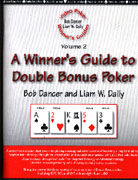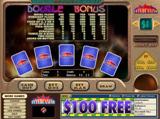More on Double Bonus Video Poker
Double Bonus Poker Variations & StrategiesThe Best Strategy for Double Double Bonus Video PokerCreating Flow Charts for Video PokerPlaying Double Bonus PokerMore on Choosing a Video Poker Machine
Video Poker Pay Table VariationsChoosing a Video Poker MachineGood Video Poker GamesThe Best Video Poker Machines
Winner's Guide Volume 2: 2nd Edition - Double Bonus Poker
by Bob Dancer
From the authors of the best-selling video poker strategy cards the Video Poker Winner's Guides cover both strategy and non-strategy aspects of play that are important for winning. Readers learn through the presentation and explanation of basic principles that take them through four levels of strategy. Strategies for full-pay as well as the more widely available non-full-pay versions are covered. Bob Dancer's well-publicized million-dollar win began with his mastery of these games.
The second edition of Volume 2 covers Double Bonus--including 10/7, 9/7, and 10/7 returning 80 for a straight flush--with standardized notation affording greater clarity and precision. A couple of strategy errors discovered in the first edition have also been corrected.
Double Bonus Video Poker Paying Back 99.1%!
Intercasino offers a Double Bonus video poker with a great payback percentage of 99.1%. Take what you've learned here at ReadyBetGo and have fun playing this great video poker variant!
Evaluating a Machine
by Bob Dancer
Two players asked me about a machine they'd seen at Suncoast. It was a 9/6 Double Bonus Triple Play machine, with progressives on each line of the Triple Play and a big bonus if you were dealt a royal. Bob Dancer is one of the world's foremost video poker experts. He is a regular columnist for Casino Player, Strictly Slots, and the Las Vegas Review-Journa land has written an autobiography and a novel about gambling. He provides advice for tens of thousands of casino enthusiasts looking to play video poker. Bob's website is www.bobdancer.com They wanted to know what level the progressives should reach before they sat down.
Bob Dancer is one of the world's foremost video poker experts. He is a regular columnist for Casino Player, Strictly Slots, and the Las Vegas Review-Journa land has written an autobiography and a novel about gambling. He provides advice for tens of thousands of casino enthusiasts looking to play video poker. Bob's website is www.bobdancer.com They wanted to know what level the progressives should reach before they sat down.
 Bob Dancer is one of the world's foremost video poker experts. He is a regular columnist for Casino Player, Strictly Slots, and the Las Vegas Review-Journa land has written an autobiography and a novel about gambling. He provides advice for tens of thousands of casino enthusiasts looking to play video poker. Bob's website is www.bobdancer.com They wanted to know what level the progressives should reach before they sat down.
Bob Dancer is one of the world's foremost video poker experts. He is a regular columnist for Casino Player, Strictly Slots, and the Las Vegas Review-Journa land has written an autobiography and a novel about gambling. He provides advice for tens of thousands of casino enthusiasts looking to play video poker. Bob's website is www.bobdancer.com They wanted to know what level the progressives should reach before they sat down.To start with, I asked them about the return on the straight. 9/6 Double Bonus comes in a version that returns 5 for 1 for the straight and also in a 4 for 1 version. They told me they thought it was 5 for 1 but they weren't sure. I said fine. We'll figure it out on that basis, but if it's different they'll know how to figure it out for themselves.
I showed them how to create the following chart:
| Sum of Royals | WinPoker Setting | Total Return |
| $3,000 | 4,000 | 97.81% |
| $4,000 | 5,333 | 98.52% |
| $5,000 | 6,667 | 99.29% |
| $6,000 | 8,000 | 100.09% |
| $7,000 | 9,333 | 100.91% |
The first column lists the sum of the three royal flushes. At the reset value, each of these games would return $1,000 and that adds up to $3,000. At this level, you shouldn't even consider playing. I listed figures for when the royals add up to $4,000, $5,000, $6,000, and $7,000. Whatever the actual sum is, you can use this chart to estimate fairly closely. For example, if the royals added up to $5,269, then the return would be about a fourth of the way between 99.29 percent and 100.09 percent --- or 99.6 percent, approximately.
The center column is the number I set the royal figure to on WinPoker. We know that $3,000 means $1,000 apiece and that is for a 4,000-coin royal. To get the royal amount for $5,000, for example, I multiplied the 4,000 royal figure by the ($5,000 / $3,000) ratio and came up with 6,667. There are equivalent ways to come up with the same number.
In my "Million Dollar Video Poker" book, I tell of a promotion at The Orleans where dealt royals paid double. To figure out how much that was worth, I divided the extra 800 coins received per coin bet by 649,640 (which is how often dealt royals occur) and came up with 0.123 percent. I use this multiplier to determine how much to add for the dealt royal progressive. I then created the following table:
| $3,000 | 0 |
| $6,000 | 0.123% |
| $9,000 | 0.246% |
| $12,000 | 0.369% |
| $15,000 | 0.492% |
| $18,000 | 0.615% |
| $21,000 | 0.738% |
| $24,000 | 0.861% |
So if the dealt royal returned, say, $19,332, I'd add about 0.67 percent to whatever figure I came up with for the return on the game. Note: a dealt royal on this machine happens every 1,200 to 1,500 hours of play, depending on how fast you are. This means eight or nine months of 40-hours-a-week play. Occasional players probably shouldn't even take this into consideration.
We also need to add in the slot club. Suncoast pays 0.25 percent usually, and double that on holidays and occasionally at other times. If they're offering something extra, such as drawing tickets for every 500 points or so, you might want to add a small amount for that.
Note that adding up the above numbers presumes you know how to play the game at all levels. This is a HEROIC, contrary to fact, assumption. On the hand Ac Ks Ts 7s 6h, for example, it takes considerable expertise to know at what royal level to switch from holding the A to the KT. Not one player in a hundred knows when to switch within a hundred dollars. Do you? And the number would be different each time if the 6h were the 9h, or the 5h, or the 5c. Or if the 7s were the 7c instead. Do you know these things? Progressives are tough!
Lastly, even though I can easily teach you how to add up these numbers, I can't answer the question of the level at which you should sit down. That has to be a personal decision. Professional teams (who generally wouldn't be working with quarter progressives anyway) each calculate their own "strike numbers." This number would be the level of the progressive when they would have their members sit down and play. This number is based on how well their players play, the level of risk the team is willing to accept, generally how easy it is to get a seat on the bank of machines and several other factors.
[ learn video poker! ]

